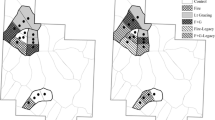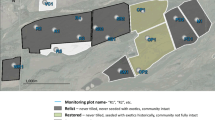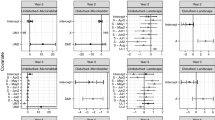Abstract
Context
Prairies historically covered much of inland North America, and many species have adapted to the unique conditions found in prairie ecosystems. Less than 1% of prairies remain in Arkansas, with much historic prairie having been converted for urban and agricultural development, resulting in steep population declines for many prairie-associated species.
Objectives
Because many reptile and amphibian species are difficult to detect, the current distributions and habitat requirements of prairie-associated herpetofauna in fragmented landscapes are poorly understood. Thus, we assessed the state of prairie-associated herpetofauna communities in intact prairie, as well in degraded and developed historic prairie throughout Western Arkansas.
Methods
Using repeated field surveys, remote sensing data, and hierarchical community occupancy models, we examined the influence of vegetation conditions, land use, and landscape characteristics on an assemblage of nine species of prairie-associated herpetofauna.
Results
Prairie mound density, representing prairie that has not been subject to intense anthropogenic disturbance, was the strongest positive predictor of occupancy by prairie-associated species. Historic prairie area also exhibited a positive relationship with occupancy for several species but not at the assemblage level. Current vegetation conditions did not strongly influence occupancy patterns.
Conclusions
Our results suggest that long-term land use filters, rather than present site-level conditions, are the driving forces dictating current distributions of prairie-associate herpetofauna in Western Arkansas. Our findings provide insight into the present state of understudied populations in an increasingly fragmented region and present accessible tools for directing exploratory conservation and research efforts.






Similar content being viewed by others
References
Alford AL, Hellgren EC, Limb R, Engle DM (2012) Experimental tree removal in tallgrass prairie: variable responses of flora and fauna along a woody cover gradient. Ecol Appl 22(3):947–958
Arkansas Natural Heritage Commission (ANHC) (2016) Natural Communities of Arkansas No. 2: Tallgrass Prairies. Poster. http://www.naturalheritage.com/Education/natural-communities-poster-series
Baskin JM, Stuckey RS, Baskin CC (1995) Variations in Transeau’s maps of the Prairie Peninsula. In: Proceedings of the fourteenth North American prairie conference: Prairie diversity. Kansas State University, Manhattan, pp 227–231
Battigelli JP, Spence JR, David WL, Berch SM (2004) Short-term impact of forest soil compaction and organic matter removal on soil mesofauna density and oribatid mite diversity. Can J For Res 34(5):1136–1149
Brotherson JD (1982) Vegetation of the mima mounds of Kalsow Prairie, Iowa. The Great Basin Naturalist, pp 246–261
Brudvig LA, Grman E, Habeck CW, Orrock JL, Ledvina JA (2013) Strong legacy of agricultural land use on soils and understory plant communities in longleaf pine woodlands. For Ecol Manag 310:944–955
Bürgi M, Östlund L, Mladenoff DJ (2017) Legacy effects of human land use: ecosystems as time-lagged systems. Ecosystems 20:94–103
Cagle NL (2008) Snake species distributions and temperate grasslands: a case study from the American tallgrass prairie. Biol Conserv 141(3):744–755
Campbell C, Campbell ID, Blyth CB, McAndrews JH (1994) Bison extirpation may have caused aspen expansion in western Canada. Ecography 17:360–362
Cavitt JF (2000) Fire and a tallgrass prairie reptile community: effects on relative abundance and seasonal activity. J Herp 12–20
Ceballos G, Davidson A, List R, Pacheco J, Manzano-Fischer P, Santos-Barrera G, Cruzado J (2010) Rapid decline of a grassland system and its ecological and conservation implications. PLoS ONE 5(1):e8562
Clark TW (1978) Current status of the black-footed ferret in Wyoming. J Wildl Manag 128–134
Corn PS, Peterson CR (1996) Prairie legacies—amphibians and reptiles. In: Samson FB, Knopf FL (eds) Prairie conservation: preserving North America’s most endangered ecosystem. Island Press, Covelo, CA, pp 125–135
Cramer MD, Barger NN (2014) Are mima-like mounds the consequence of long-term stability of vegetation spatial patterning? Paleogeogr Paleoclimatol Paleoecol 409:72–83
Delaney KS, Busteed G, Fisher RN, Riley SP (2021) Reptile and amphibian diversity and abundance in an urban landscape: impacts of fragmentation and the conservation value of small patches. Ichthyol Herpetol 109(2):424–435
Dixon P (2003) VEGAN, a package of R functions for community ecology. J Veg Sci 14:927–930
Dorazio RM, Royle JA (2005) Estimating size and composition of biological communities by modeling the occurrence of species. J Am Stat Assoc 100:389–398
Dorazio RM, Royle JA, Soderstrom B, Glimskar A (2006) Estimating species richness and accumulation by modeling species occurrence and detectability. Ecology 87:842–854
Durso AM, Willson JD, Winne CT (2011) Needles in haystacks: estimating detection probability and occupancy of rare and cryptic snakes. Biol Conserv 144(5):1508–1515. https://doi.org/10.1016/j.biocon.2011.01.020
Fitch HS (2006a) Ecological succession on a natural area in northeastern Kansas from 1948 to 2006. Herpetol Conserv Biol 1(1):1–5
Fitch HS (2006b) Collapse of a fauna: reptiles and turtles of the University of Kansas Natural History Reservation. J Kansas Herpetol 17:10–13
Fitch HS, Hall ER (1978) A 20-year record of succession on reseeded fields of tallgrass prairie on the Rockefeller Experimental Tract. Natural History Museum, University of Kansas, Kansas
Foster DR, Motzkin G, Slater B (1998) Land-use history as long-term broad-scale disturbance: regional forest dynamics in central New England. Ecosystems 1(1):96–119
Fowler A (ed) (2015) Arkansas Wildlife Action Plan (AWAP). Arkansas Game and Fish Commission, Little Rock, Arkansas, p 1678
Gabet EJ, Perron JT, Johnson DL (2014) Biotic origin for Mima mounds supported by numerical modeling. Geomorphology 206:58–66
Galán AP, Light JE (2017) Reptiles and Amphibians Associated with Texas Pocket Gopher (Geomys personatus) Burrow Systems Across the Texas Sand Sheet. Herpetol Rev 48(3):517–521
Garden JG, McAlpine CA, Possingham HP, Jones DN (2007) Habitat structure is more important than vegetation composition for local-level management of native terrestrial reptile and small mammal species living in urban remnants: a case study from Brisbane, Australia. Aust Ecol 32(6):669–685
Greenberg CH, Neary DG, Harris LD (1994) Effect of high-intensity wildfire and silvicultural treatments on reptile communities in sand-pine scrub. Conserv Biol 8(4):1047–1057. https://doi.org/10.1046/j.1523-1739.1994.08041047.x
Haggerty CJ, Crisman TL, Rohr JR (2019) Effects of forestry-driven changes to groundcover and soil moisture on amphibian desiccation, dispersal, and survival. Ecol Appl 29(3):e01870
Hayden TJ (2014) US military installations as bioreserves: a case study from Fort Hood, Texas. Military Geosciences in the Twenty First Century. Geological Society of America, North Carolina, vol 215, pp 101–108
Heemeyer JL, Lannoo MJ (2012) Breeding migrations in Crawfish Frogs (Lithobates areolatus): long-distance movements, burrow philopatry, and mortality in a near-threatened species. Copeia 3:440–450
Heemeyer JL, Williams PJ, Lannoo MJ (2012) Obligate crayfish burrow use and core habitat requirements of Crawfish Frogs. J Wildl Manag 76(5):1081–1091
Hodgkison S, Hero JM, Warnken J (2007) The efficacy of small-scale conservation efforts, as assessed on Australian golf courses. Biol Conserv 135(4):576–586
Horwath JL, Johnson DL (2006) Mima-type mounds in southwest Missouri: expressions of point-centered and locally thickened biomantles. Geomorphology 77:308–319
Hunt JW, Weckerly FW, Ott JR (2012) Reliability of occupancy and binomial mixture models for estimating abundance of Golden-cheeked Warblers (Setophaga chrysoparia). Auk 129:105–114
Jellinek S, Driscoll DA, Kirkpatrick JB (2004) Environmental and vegetation variables have a greater influence than habitat fragmentation in structuring lizard communities in remnant urban bushland. Austral Ecol 29(3):294–304
Johnson NB, Poulin RG, Somers CM (2022) Thermoregulation by bullsnakes (Pituophis catenifer sayi): do burrows make life easier on the prairies? Can J Zool 100(999):303–314
Kéry M, Royle JA (2015) Applied hierarchical modeling in ecology: analysis of distribution, abundance and species richness in R and BUGS. Volume 1: prelude and static models. Academic Press, Salt Lake City, Utah
Kross CS, Willson JD (2022) Population decline and landscape-scale occupancy of the crawfish frog (Lithobates areolatus) in Northwest Arkansas. Ichthyol Herpetol 110(1). https://doi.org/10.1643/h2020147
Larson DM (2014) Grassland fire and cattle grazing regulate reptile and amphibian assembly among patches. Environ Manag 54(6):1434–1444
Lauenroth WK, Burke IC, Gutmann MP (1999) The structure and function of ecosystems in the central North American grassland region. Great Plains Research 223–259
Lesbarrères D, Ashpole SL, Bishop CA, Blouin-Demers G, Brooks RJ, Echaubard P, Govindarajulu P, Green DM, Hecnar SJ, Herman T, Houlahan J, Litzgus JD, Mazerolle MJ, Paszkowski CA, Rutherford P, Schock DM, Storey KM, Lougheed SC (2014) Conservation of herpetofauna in northern landscapes: threats and challenges from a Canadian perspective. Biol Conserv 170:48–55
Martínez-Estévez L, Balvanera P, Pacheco J, Ceballos G (2013) Prairie dog decline reduces the supply of ecosystem services and leads to desertification of semiarid grasslands. PLoS ONE 8(10):e75229
Mazerolle M, Bailey LL, Kendall WL, Royle JA, Converse SJ, Nichols JD (2007) Making great leaps forward: accounting for detectability in herpetological field studies. J Herpetol 41(4):672–689. https://doi.org/10.1670/07-061.1
McLaughlin A, Mineau P (1995) The impact of agricultural practices on biodiversity. Agric Ecosyst Environ 55(3):201–212
Paletto A, Tosi V (2009) Forest canopy cover and canopy closure: comparison of assessment techniques. Eur J For Res 128:265–272
Quinn JH (1961) Prairie mounds of Arkansas. Arkansas Archeol Soc 2:1–7
R Core Team (2019) R: a language and environment for statistical computing. R Foundation for Statistical Computing, Vienna
Ribeiro JW, Siqueira T, Brejão GL, Zipkin EF (2018) Effects of agriculture and topography on tropical amphibian species and communities. Ecol Appl 28(6):1554–1564. https://doi.org/10.1002/eap.1741
Risser PG (1988) Diversity in and among grasslands. In: Wilson EO (ed) Biodiversity. National Academy Press, Washington, pp 176–180
Risser PG, Birney EC, Blocker HD, May SW, Parton JW, Wiens JA (1981) The True Prairie Ecosystem. Hutchinson Ross, Stroudsburg, Penn
Robel RJ, Briggs JN, Dayton AD, Hulbert LC (1970) Relationships between visual obstruction measurements and weight of grassland vegetation. J Range Manag Arch 23(4):295–297
Roberts KG (2020) Arkansas Herpetological Atlas 2019: Distributions of Amphibians and Reptiles. http://www.herpsofarkansas.com/Herp/Atlas; Accessed Nov 2020
Sampson FB (1980) Island biogeography and the conservation of prairie birds. In: Kurera CL (ed) Seventh North American Prairie Conference, Proceedings. Southwest Missouri State University, Springfield, Mo, pp 293–299
Sampson FB, Knopf FL (1994) Prairie conservation in North America. Bioscience 44:418–421
Seifert CL, Cox RT, Forman SL, Foti TL, Wasklewicz TA, McColgan AT (2009) Relict nebkhas (pimple mounds) record prolonged late Holocene drought in the forested region of south-central United States. Quatern Res 2009:329–339
Shipley BK, Reading RP (2006) A comparison of herpetofauna and small mammal diversity on black-tailed prairie dog (Cynomys ludovicianus) colonies and non-colonized grasslands in Colorado. J Arid Environ 66(1):27–41
Sovic M, Fries A, Martin SA, Gibbs LH (2019) Genetic signatures of small effective population sizes and demographic declines in an endangered rattlesnake, Sistrurus Catenatus. Evol Appl 12(4):664–678
Steen DA, Barrett K (2015) Should states in the USA value species at the edge of their geographic range? J Wild Manag 79(6):872–876
Svedarsky WD, Westemeier RL, Robel RJ, Gough S, Toepher JE (2000) Status and management of the Greater Prairie-Chicken Tympanuchus cupido pinnatus in North America. Wild Biol 6(4):277–284
Swab RM, Lorenz N, Lee NR, Culman SW, Dick RP (2020) From the ground up: prairies on reclaimed mine land—impacts on soil and vegetation. Land 9(11):455
Tack JD, Quamen FR, Kelsey K, Naugle DE (2017) Doing more with less: removing trees in a prairie system improves value of grasslands for obligate bird species. J Environ Manag 198:163–169
Todd BD, Luhring TM, Rothermel BB, Gibbons JW (2009) Effects of forest removal on amphibian migrations: implications for habitat and landscape connectivity. J Appl Ecol 554–561
Transeau ED (1935) The prairie peninsula. Ecology 16:423–437
Trauth SE, Robison HW, Plummer MV (2004) The amphibians and reptiles of arkansas. The University of Arkansas Press, Fayetteville
van der Kamp G, Hayashi M, Bedard-Haughn A, Pennock D (2016) Prairie pothole wetlands–suggestions for practical and objective definitions and terminology. Wetlands 36(2):229–235
Voldseth RA, Johnson WC, Gilmanov T, Guntenspergen GR, Millett BV (2007) Model estimation of land-use effects on water levels of northern prairie wetlands. Ecol Appl 17(2):527–540
Washburn, AL (1988) Mima mounds, an evaluation of proposed origins with special reference to the Puget Lowlands. Report of Investigations, State of Washington Department of Natural Resources, Division of Geology and Earth Resources Report no. 29. Olympia, Washington.
Weir LA, Royle JA, Gazenski KD, Villena O (2014) Northeast regional and state trends in anuran occupancy from calling survey data (2001–2011) from the North American Amphibian Monitoring Program. Herpetol Conserv Biol 9:223–245
Whisler KM, Rowe HI, Dukes JS (2016) Relationships among land use, soil texture, species richness, and soil carbon in Midwestern tallgrass prairie, CRP and crop lands. Agric Ecosyst Environ 216:237–246
White SE, Faulk E, Tzilkowski C, Weber A, Marshall M, Wagner T (2020) Predicting fish species richness and habitat relationships using Bayesian hierarchical multispecies occupancy models. Can J Fish Aquat Sci 77(3):602–610
Wilgers DJ, Horne EA, Sandercock BK, Volkmann AW (2006) Effects of rangeland management on community dynamics of the herpetofauna of the tallgrass prairie. Herpetologica 62(4):378–388
Wright HA, Bailey W (1982) Fire ecology: United States and southern Canada. Wiley, New York
Zipkin EF, DeWan A, Royle JA (2009) Impacts of forest fragmentation on species richness: a hierarchical approach to community modelling. J Appl Ecol 46:815–822
Acknowledgements
We thank Max Carnes-Mason, Alex Meinders, Matt Gideon, Dr. Jennifer Mortensen, Kory Roberts, Bailey Singleton, Dr. Meredith Swartwout, and Gabriel Yerdon for their work in the field. We thank the Marley, Stokenbury, and Thrailkill families, Terry Stanfill, and Polly Canez and the Horses for Healing staff for access to their properties. We are extremely grateful for the support of Elizabeth Phillips, SGT. Jobe, and the Fort Chaffee range control staff for their assistance in accessing sites at Fort Chaffee. We thank Joe Woolbright, Kelly Irwin, Dustin Lynch, Theo Witsell and the Arkansas Natural Heritage Commission, Bruce Shackleford, Seth Pickens, Jeff Hickle and the City of Fayetteville, Alan Edmundson, Marson Nance and the Northwest Arkansas Land Trust, and Joe Adams and the Charlie F. Craig Fish Hatchery for information and property access. We thank Matthijs Hollanders for input on occupancy model structure. We thank Dr. Steve Beaupre, Dr. Dan Greene, Dr. Lauren Maynard, and two anonymous reviewers for constructive comments on the manuscript. We thank Kory Roberts for his work in the field and on the Arkansas Herpetological Atlas, and for his willingness to share his extensive knowledge of herpetofauna in Arkansas.
Funding
Funding for this project was provided by a State Wildlife Grant from the Arkansas Game and Fish Commission (AGFC; RG-2708), the Arkansas Audubon Society Trust, Prairie Biotic Research, Inc., Ozark Ecological Restoration Inc., and the University of Arkansas. Additional support for EJR and conference travel was provided by the University of Arkansas and the University of Arkansas Graduate School Doctoral Academy Fellowship.
Author information
Authors and Affiliations
Contributions
CSK and JDW conceptualization and funding acquisition, CSK, JDW, and EJR methodology, CSK and EJR performed field work and data management, EJR performed statistical analyses, prepared figures, and wrote main manuscript text. CSK, JDW, and EJR edited manuscript. All authors reviewed the manuscript and approved the final draft.
Corresponding author
Ethics declarations
Competing interests
The authors declare no competing interests.
Additional information
Publisher's Note
Springer Nature remains neutral with regard to jurisdictional claims in published maps and institutional affiliations.
Supplementary Information
Below is the link to the electronic supplementary material.
Rights and permissions
Springer Nature or its licensor (e.g. a society or other partner) holds exclusive rights to this article under a publishing agreement with the author(s) or other rightsholder(s); author self-archiving of the accepted manuscript version of this article is solely governed by the terms of such publishing agreement and applicable law.
About this article
Cite this article
Royal, E.J., Kross, C.S. & Willson, J.D. Legacy land use predicts occupancy patterns of prairie-associated herpetofauna in Western Arkansas. Landsc Ecol 38, 423–438 (2023). https://doi.org/10.1007/s10980-022-01564-z
Received:
Accepted:
Published:
Issue Date:
DOI: https://doi.org/10.1007/s10980-022-01564-z




